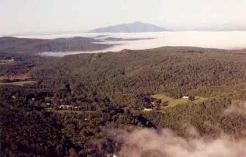|
--What are Unfragmented Lands?
--What does the map of unfragmented lands show?
--Why are unfragmented landsimportant?
--What threatens unfragmented lands?
--What do we need to know about unfragmented lands in Plainfield?
--What is next?
-- Where can I get more information?
What are unfragmented lands?
Large blocks of undeveloped land are an important natural resource in a developing region. Unfragmented blocks of habitat are large pieces of land which are not bisected by a maintained (Class V or better) road; typically there are few or no houses, businesses or other human habitation. These areas can include forests, meadows, open water, wetlands, and agricultural fields. It is important to note that these blocks normally include many different landowner parcels.
What does the map show?
The Unfragmented Lands Map (195kb) shows that Plainfield has blocks of various sizes. These areas carry over into neighboring towns and that is the reason for the one-mile buffer shown on the map. The NRI committee used existing land use and road information to identify contiguous undeveloped land in seven size classes shown in the table below. The map shows several blocks that have a small amount of acreage in Plainfield but when the acreage is combined with contiguous blocks in adjacent towns the block becomes more significant. Note that what is considered “large” varies, depending on the context of the block; a parcel of land which would be considered unremarkable in Plainfield could be extremely significant in an urban setting.
Acreage |
25-99 |
100-499 |
500-999 |
1,000-3,999 |
4,000-9,999 |
10,000-29,000 |
>30,000 |
Number of Blocks |
5 |
16 |
3 |
3 |
2 |
0 |
1 |
Why are unfragmented lands important?
Unfragmented blocks of land sustain diverse communities of plant and animal species by providing critical ‘islands’ of habitat for species that would otherwise not be able to survive here. In addition, these blocks provide recreational opportunities for the community and often provide or protect important scenic resources. In the Plainfield Master Plan Survey, ‘open spaces’ and ‘rural character’ were among the most frequently identified “Community Cornerstones” which give Plainfield its character. Unfragmented lands are an important community resource.
- Larger blocks of contiguous undeveloped land support a wider variety of wildlife species. Some examples of species requirements are shown in Appendix ??.
- Rare species of plants are more likely to occur where there is less threat of disturbance.
- Undivided blocks of land provide remote recreational opportunities for hikers, hunters, skiers, snowmobilers and others.
- Undisturbed land helps maintain high water quality for human consumption and aquatic ecosystems.
What threatens unfragmented lands?
The primary threats to this resource in most communities including Plainfield are development and the impact humans have on habitats. A primary characteristic of unfragmented habitat is the absence of maintained roads. These are a source of wildlife mortality and a barrier to wildlife movement. The impact of roads varies with their type and intensity of use. However, frequent traffic often creates an insurmountable barrier to mammals, amphibians and reptiles. Appendix E illustrates the importance of habitat block size for various species of wildlife.
What do we need to know?
Preserving large blocks of land is a difficult task. Any effort to do this requires that we find ways to protect the economic interests of land-owners at the same time that we are protecting the conservation value of the land. Educating current land owners about the conservation value of their lands and encouraging them to voluntarily conserve or protect those parcels seems like an obvious next step. However, even this effort would benefit from more specific information about the plant and animal species in Plainfield which need habitat protection, and that effort requires outside support and additional funding. Another goal should be to identify specific parcels which have special conservation value so that the Town, the Conservation Commission, and the landowners involved would all know that the community has a special interest in protecting those parcels should the opportunity arise. In the end, we must find a path which allows all parties to benefit.
Setting Priorities -- What’s next?
- Educate people on the importance of having large blocks of undeveloped habitat to certain species of wildlife.
- Map specific land cover and wildlife habitat in the Town’s large unfragmented blocks of land.
- Identify land parcels which have the greatest conservation value because they contain significant plant or animal habitat or because their location could expand existing conserved lands or because of their value as a public resource.
- Educate landowners about the benefits of voluntary land conservation and encourage donations of conservation and agricultural easements to permanently protect tracts of important conservation land.
- Identify plant and animal species in Plainfield which are most sensitive to development.
- Evaluate the effectiveness of current zoning and building regulations which promote “conservation design” and recommend appropriate modifications.
Where to find more information:
|



